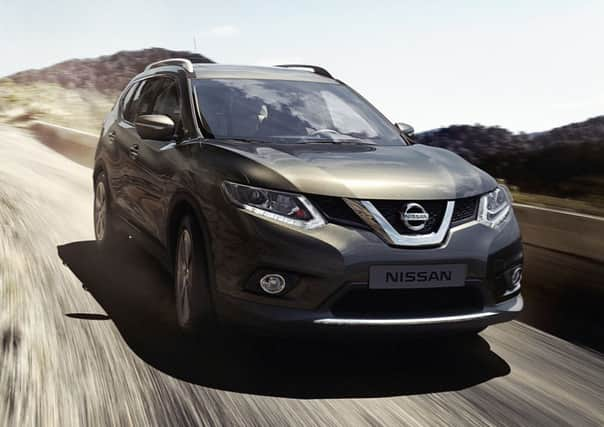First Drive: Nissan X-Trail 1.6 dCi


Thirteen years after the introduction of the hugely successful X-Trail – and heading for two million worldwide sales – Nissan wanted to find out how to make it better, so it asked the people who used them every day. There are plenty of them, with the car now being sold in 190 countries around the world.
Here in Britain, the X-Trail has a loyal band of customers and those who were surveyed by Nissan were generally enthusiastic about its ability and ruggedness but felt that some tweaks to create more space inside for passengers and their luggage as well as more advanced technology would make it even better.
Advertisement
Hide AdAdvertisement
Hide AdSo when the third generation of the car appears in the showrooms in July, it’s going to get a warm welcome from existing owners and will bring in new customers – what the business calls “conquests” – attracted by the package on offer.
The new version has been completely redesigned and repositioned in the marketplace and in the Nissan range itself. Until now the X-Trail has been pretty well under the SUV offroader banner alongside more serious Nissan contenders like the massive Patrol, the Discovery lookalike Pathfinder and the Navara pickup. The latest version has been moved sideways to sit between those big boys and the small crossover range like the hugely successful Juke and Qashqai to establish a position of its own.
Some may say that it’s gone soft – but far from it. It’s available in two-wheel-drive but the 4x4 version has just the same capability as the outgoing model. In fact, it should be even better, coming with an all-new advanced electronic four-wheel-drive system. It’s controlled through a rotary switch on the central console to call up a choice of two-wheel-drive, auto mode or lock for permanent four-wheel-drive in tricky conditions. In the standard auto setting, the system monitors the throttle, engine speed and torque to anticipate wheel spin and distributes power between the front and rear axles.
Nissan say the new car has three core values based on what customers told them – to be stylish and refined; practical and roomy; and equipped with the latest technology and innovation.
Externally, the car has been softened in its overall appearance, moving away from the squared-off styling of its predecessor to have more curves and flowing lines including a dipping roofline. It looks good, with a nice family-themed front end with bold LED lighting, and it’s easier on the eye at the rear which now has a powered tailgate.
On the sides, it has deeply sculpted flanks and a rising window line along with stronger wheel arches and more significant rear pillars. The car is wider, lower and 17mm longer than the outgoing model but has a 76mm longer wheelbase which has helped create the big changes on the inside to give a massive 660mm of legroom for rear seat passengers – 20 per cent more than on the current model. It’s also 90kg lighter – the plastic tailgate has saved 7kg alone – to help contribute to an 18 per cent improvement in economy.
The test car was the five-seater version but the range has been designed from the outset to include the optional seven seats with raked theatre-type seating so that every passenger has a clear view ahead, rather than staring at a seat back. The second row seats slide and recline for flexibility and to balance passenger and loadspace at the rear, where there’s now a double load floor with nine separate positions.
The interior has a much improved quality feel, with chrome and piano black features, and every contact surface such as door armrests and centre console has been given extra padding which Nissan claim is eight times thicker than in the competition. The test car came with a large powered glass panoramic roof, the biggest in its class, which not only draws in light but has an opening front half for extra ventilation.
Advertisement
Hide AdAdvertisement
Hide AdOn the technology front, the latest generation of NissanConnect brings together satnav, information and entertainment including integrating Google to access weather forecasts and the like through the seven-inch colour touch screen. The top of the range Tekna test car came with a new 1.6-litre, 128bhp four-cylinder diesel engine which is more efficient and cleaner and, although smaller, produces the same amount of torque as the previous two-litre unit.
The X-Trail’s new technology includes Nissan’s Safety Shield, a collection of automatic features to reduce the consequences of an accident, or to stop it happening in the first place. As well as driver attention alert, blind spot and lane departure warning, there’s also forward emergency braking which alerts the driver if the gap between the car in front is closing – and if no action is taken, the brakes are automatically progressively applied. Active ride control alters the suspension damping to deal with undulating road surfaces, active engine brake helps with control when decelerating, and active trace control reduces under-steer, especially on slippery, wet roads.
Nissan is full of confidence about this car which it admits is crucial to its business. I suspect that those focus group X-Trailers are going to enjoy seeing their loyalty has been rewarded with significant improvements.
VITAL STATS
Car Nissan X-Trail 1.6 dCi 4WD Tekna
Price £30,995
Engine 1.6-litre turbodiesel, 4cyl, 128bhp, 236ft lb
Performance Top speed 116mph; 0-62mph 11 secs
Economy 53 mpg combined
CO2 emissions 139g/km